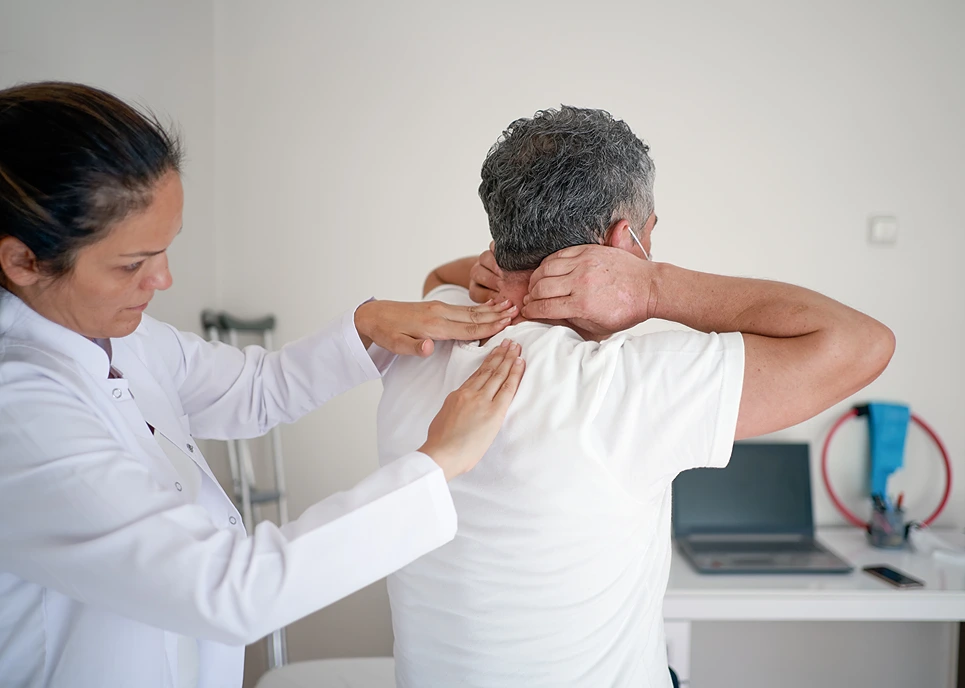Addressing Pain at the Critical Junction of Neck and Spine
Neck and upper back pain is a growing concern, not just among those frequently using digital devices but across various lifestyles and age groups. It’s a complex condition influenced by several factors including posture, physical activity, age, and even emotional stress.
In this comprehensive guide, we explore the common causes, symptoms, and effective treatments for neck and upper back pain. We’ll also get into how these pains can be indicative of more serious health issues and the importance of recognizing when professional help is needed.
Whether caused by everyday habits or underlying medical conditions, understanding these aspects is key to managing and potentially alleviating this discomfort.
Find relief from neck-spine junction pain. Use Kaly to explore treatment options with qualified healthcare professionals.
What Causes Upper Back and Neck Pain?

Muscular Strain Due to Poor Posture
Muscular problems, often originating from incorrect posture and restricted movement, are the main cause of neck and upper back discomfort.
Bending the neck to look at phones or computer screens strains the muscles, tendons, and ligaments in these areas.
The upper trapezius muscles, situated between the neck and shoulders, are especially prone to tightness and spasms due to continuous forward hunching.
Joint Problems in the Cervical Spine
Joint issues in the cervical spine, such as cervical spondylosis, arthritis, and disc problems, can also contribute to neck discomfort or stiffness. These conditions often lead to inflammation and may compress nerves.
Additionally, whiplash injuries from car accidents are a common cause of trauma to the neck’s delicate vertebrae and soft tissues.
Common Symptoms: Stiffness, Pain, and Limited Motion
These muscular and joint issues usually result in local stiffness, tenderness, and pain in the neck and upper back. Headaches that originate at the base of the skull are a frequent accompaniment to this neck discomfort.
Depending on where the nerves are impinged, pain or numbness may radiate down one or both arms. A limited range of motion can also make it challenging to turn the head or look up and down.
How Do Movement and Posture Affect Neck and Upper Back Pain?

Our everyday postures and movements significantly impact neck and upper back health. Sitting hunched over a screen for hours restricts the neck’s ability to extend backward. This flexion-sensitive pain worsens when looking up or holding the head upright.
Conversely, some suffer from extension-sensitive neck pain due to compressed facet joints in the vertebrae. Symptoms increase when leaning the head backward or turning the neck.
Poor shoulder and mid-back posture also contribute to neck dysfunction. Rounded shoulders and a forward head tilt increase the strain on the cervical spine to hold the head upright.
Weak postural muscles allow the head to shift forward and the neck to bend forward during daily activities.
Targeted movement and postural exercises help retrain the muscles to better support the neck and head. Improving mid-back mobility also allows the shoulders to move backward, decreasing pressure on the neck.
Why Does Neck Pain Sometimes Radiate Down the Spine?
Neck pain often radiates down the spine into the upper back and arms when cervical nerve roots become irritated or compressed.
The cervical nerves exit the spinal cord through intervertebral foramen between each vertebra. Swelling, bone spurs, herniated discs, or other spinal issues can impinge these nerves as they travel through the neck.
Pinched or inflamed cervical nerves produce pain that follows the nerves’ paths into the upper back, shoulders, and arms. Numbness, tingling, and weakness may also occur in the areas connected to the affected nerves.
For example, nerve root compression in the C5 to C7 region could cause symptoms down the shoulder, upper arm, and forearm. Identifying the location of radiating pain provides clues about the site of nerve involvement.
End your struggle with neck-spine pain. Kaly is your gateway to specialized medical advice and care solutions.
What Different Types of Neck Pain Exist and How Are They Diagnosed?
Doctors categorize neck pain based on the underlying muscular, nerve, or spinal involvement. Accurate classification through physical exams and imaging helps determine appropriate treatments.
- Muscular neck pain results from strained neck muscles and tendons. Trigger points and muscle spasms create local tenderness. Limited range of motion occurs but nerve function remains intact.
- Nerve-related neck pain happens when cervical nerves become compressed or irritated. Pain radiates down the arm in patterns corresponding to the nerve. Numbness, tingling, and weakness often occur distally.
- Spinal neck pain originates from joint, disc, or vertebral problems. Symptoms include stiffness and reduced mobility, along with muscle spasms. Pain usually remains localized to the spinal area.
Diagnostic charts illustrate nerve patterns while imaging like x-rays, CT scans, and MRIs identify areas of spinal degeneration, disc herniation, fractures, bone spurs, and instability. These tools allow accurate diagnosis of the neck pain’s root cause.
What Are Effective Treatments for Neck and Upper Back Pain?

A variety of nonsurgical treatment options exist for managing neck and upper back discomfort:
- Physical therapy helps relieve muscular tightness through massage, joint mobilization, and range of motion exercises. Posture retraining may also be incorporated.
- Over-the-counter anti-inflammatories and muscle relaxants provide short-term pain relief. Narcotic medications are avoided due to risks.
- Alternative approaches like chiropractic adjustments, acupuncture, and mindfulness practices can aid recovery. Proper spine alignment reduces nerve pinching.
- Ergonomic adjustments such as posture reminders and screen height modification prevent strain from repetitive poor postures.
- Cortisone injections around inflamed nerves or into tight muscles offer temporary symptom relief.
Surgery may become necessary depending on the spinal condition. Options range from removing bone spurs and damaged discs to cervical spinal fusion for instability. Recovery times vary considerably.
Lifestyle measures like weight loss, regular movement, and stress reduction complement medical treatment. A multifaceted approach provides the most effective path to reducing neck and upper back discomfort.
When to Seek Professional Help for Neck and Upper Back Pain?

Most neck or upper back pain improves within a few weeks using conservative self-care. Certain red flag symptoms warrant an urgent visit to a doctor for evaluation.
- Difficulty with balance, coordination, or walking may indicate spinal cord compression.
- Pain that radiates down both arms can signal severe nerve impingement.
- Bowel or bladder incontinence, or saddle anesthesia around genitals points to a spinal emergency.
- Fever, immunosuppression, history of IV drug use, or other infection clues require examination to rule out abscess.
- Trauma from falls, motor vehicle accidents, or sports requires imaging to assess spinal stability.
- Progressive pain or neurological symptoms suggest the need for prompt medical assessment.
Platforms like Kaly make finding licensed medical professionals for evaluation and treatment straightforward. Don’t ignore warning signs of potential spinal issues. Seeking timely care leads to the best neck and upper back pain outcomes.
FAQs on Neck-Spine Junction Pain
Can Emotional Stress Contribute to Neck-Spine Junction Pain?
Yes, emotional stress and psychological factors can worsen neck-spine junction pain due to the mind-body connection. Implementing effective stress management techniques is essential in reducing these symptoms and should be a part of therapeutic plans.
How Does Aging Influence Neck-Spine Junction Pain?
With aging, degenerative changes in the cervical spine become more common, raising the likelihood of experiencing pain in this area. Regular posture assessments and targeted interventions are crucial in managing age-related discomfort at the neck-spine junction.
Are Specific Dietary Choices Beneficial for Neck-Spine Pain?
Addressing neck-spine pain can benefit from dietary approaches that focus on reducing inflammation. Incorporating nutrients like omega-3 fatty acids and vitamin D may help manage such pain.
Could Pain in the Neck-Spine Junction Indicate Serious Neurological Issues?
Neck-spine junction pain could be a sign of conditions like cervical spondylosis. In more severe cases, it might indicate a heightened risk of meningitis. A thorough clinical evaluation is necessary to address any potential neurological complications.
Is There a Link Between Exercise and Neck-Spine Junction Pain?
Yes, certain exercises, especially those involving improper posture, can worsen neck-spine junction pain. Evaluating personal physical activity and sleep habits is crucial for creating customized plans to reduce discomfort and promote spinal health.
Struggling with pain where your neck meets your spine? Connect with Kaly for specialized medical guidance tailored to your needs.
